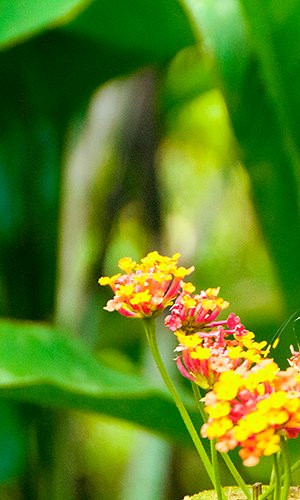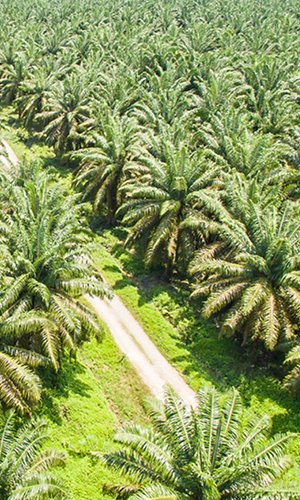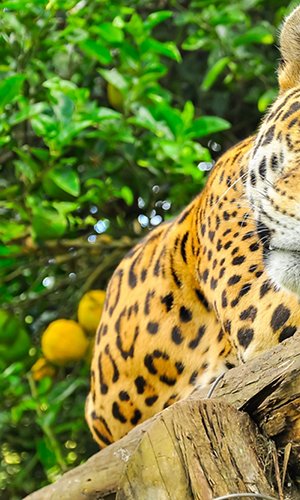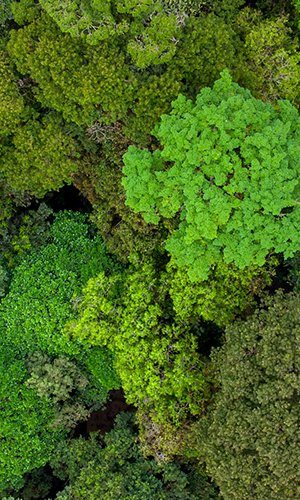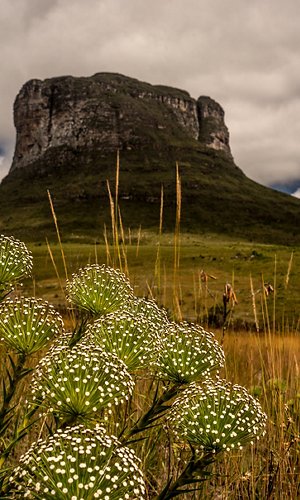Generally, near the equator, in the evening, heavy storms accompanied by large amounts of rain fall every day. The temperature is rather high, without great variations during the year, and is accompanied by a remarkable humidity in the air. Thanks to this climate the trees find the ideal conditions for their development: consequently, in the equatorial regions enormous tropical forests extend across the land. In a tropical rain forest, we find the largest variety of plants and animals to be found in nature. Many leaves have a shape that suited to allow excess water to be channelled and drip away, while dozens of metres above the ground, the leaves of the taller trees join to form a green roof that is pierced only by trees that are as tall as twenty storey buildings. This green roof does not let much light pass, and there are plants that, in order to capture the light, grow on the trunk or on the branches of the taller plants. Here animals feed on nectar, fruit, seeds and leaves.
Voice search
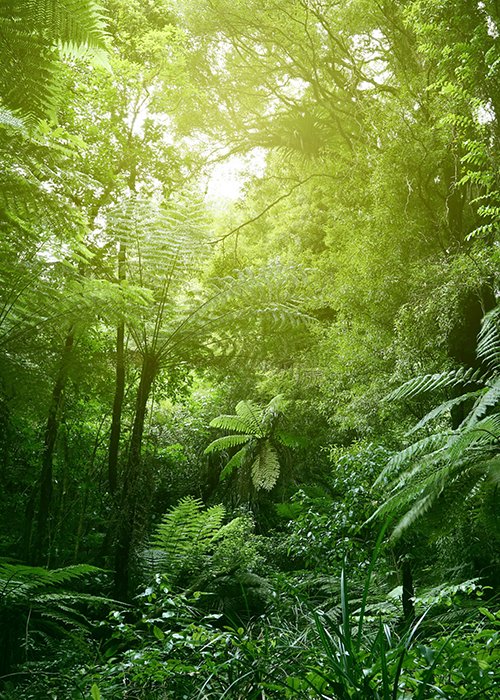
All tropical or rain forests were originally woods located between the Tropic of the Cancer (23° and 27' N) and the Tropic of the Capricorn (23° e 27’ S). This area typically has a mean temperature of approximately 25°C with oscillations of no more than 2-3 degrees and plenty of rainfalls (over 1,500 mm a year). In some forests, the annual rainfall may reach 11,000 mm, even if in most areas it is around 2,500 mm. The best word to describe this forest actually is "rainforest". In some forests it rains little but every day (rainforests or equatorial forests), while in others (in the south-east of Asia) dry and rainy periods alternate (tropical or monsoon forests). Nevertheless, for the sake of clarity, the terms "rainforest" and "tropical forest" will be considered as equivalent.
Related topic
Tropical forests in the world
Tropical forests, or rainforests, occupy the so-called inter-tropical area of the planet, that is the area between the Tropic of the Cancer and that of the Tropic of the Capricorn. Large rainforests are mainly in Latin America (Amazonia) where they are called selva, in Africa (Congo, Cameroon, Madagascar, etc.), in the Indo-Malay area (Philippines, Indonesia, etc.) where they are called "jungle" (from the Sanskrit jangala) and in the Australian area (Australia, New Guinea); altogether, they cover 10% of the lands above sea level.
Characteristics of the tropical forest
Because of the lack of seasonal differences, due to the geographical location of the forests, and the high humidity level the vegetation is luxuriant here. The recurring features of rainforests are basically the following: high animal and vegetal biodiversity; evergreen trees; dark and sparse undergrowth interspersed with clearings; scanty litter (organic matter settling on the ground); presence of "strangler" creepers (e.g. Ficusspp.); presence of “buttresses” (i.e. large winged ribs at the base of trunks) and spindly roots in trees living in often-flooded areas.
A thick forest
The foliages of trees are very close to each other and form a very thick canopy. Only approximately 1% of the light that gets to the canopy reaches the ground and so the lower branches are too dark to let leaves develop and there's virtually no undergrowth. In particular, there are very few herbaceous species. Moving up from 1 to 20 m above ground, we still find a moderate light (approximately 5%), high humidity and no wind at all. This means there are very few plants with anemogamous pollination, which means pollinated by the wind.
The animals of the tropical forest
There are three essential aspects of tropical fauna:
huge number of different species; few individuals per species; wide variety of survival strategies, morphological (i.e. different body shapes) and behavioural adaptations. For instance, in the French Guyana alone there are 76 different species of snakes versus approximately 20 in Italy; this figure could lead us to imagine that in this forest one would literally tread on a tangle of reptiles. In fact, despite the huge number of species of snakes, they are so few one could walk for miles in the forest without seeing any.
Animals of the canopy
The great vertical development of the vegetation forced many animal species to adapt to move on trees and in the air to reach many sources of food, such as leaves, flowers, seeds and fruits that are in the tall foliage. In some tropical areas (for instance in Borneo), the arboreal species make up 45% of the total amount; in temperate forests, they are only 5 –15%. The morphological adaptations developed by some species include prehensile tails, extremely developed muscles, claws that have a grip on trunks and branches (for instance the arboreal pangolin, Mamis spp. in Asia and Africa).
Life in the shade
For each forest layer, there are different habitats and therefore different animals, apart from a few exceptions, such as, for instance, insects that can be found on the ground, on the foliages or in intermediate layers. Starting from the ground and going back up along the different layers through to the limit of the tallest foliages, we can find animals adapted to different habitats. The soil of the tropical forest typically has a scanty hypogean flora (of the subsurface); there are actually very few earthworms and the most common underground larvae are those of cicadas and coleopters feeding on plant roots and sap.
The lungs of the world
For over one hundred million years, the tropical forest has played a crucial role: it serves an extraordinary and relentless biological and geopedological function which is absolutely necessary for men and animals to survive. Firstly, the trees protect the ground from the erosion of the rain and have a role in the earth-air circulation of water. Transpiration is a way to transfer water from the ground to the air: this occurs through the pores of the leaves, the stomas. In a forest with a thick vegetal covering, more than 80% of water leaves the ground through transpiration.
Many different species
The exact number of species living on Earth is unknown. Some studies suggest there must be between 10 and 50 million living species and of these, only 1.5 million have so far been classed. Overall, these figures are named biodiversity (diversity of life). The word biodiversity is used to describe the number and variety of organisms living on Earth. It is defined in terms of genetic inheritance (concerning the variation of genes between species), species (concerning the variety of species in a region) and ecosystems, which are the result of over 3 billion years' evolution.
The origin of tropical forests
Until last century, tropical forests were larger than they are today. Fossil finds prove that forests developed in the Tertiary period (between 65 and 2 million years ago) in south-eastern Asia and their flora was not different from today's. Some aspects of their structure in the late Pleistocene (after the last glaciations, 10,000 years ago) have been explored by palaeontology (the science that deals with ancient living beings through fossils) and bio-geography (the science that deals with the geographical distribution of living beings on the earth's surface and its causes).
Carbon sequestration
Forests help to remove carbon dioxide from the atmosphere and transform it, through photosynthesis, into carbon, which the forests then “saved” in the form of wood and vegetation. This process is called “carbon sequestration”. Generally, approximately 20% of the weight of trees consists of carbon, and the entire biomass of the forest acts as a “carbon absorption tank”. Also the organic material in the ground in the forests, as for example humus that derives from the decomposition of dead plant material, acts as a carbon tank.
Read more...
Approximately 10% of today's drugs derive from tropical medicinal plants, including quinine, curare and a number of steroids. Three thousand plants have anti-cancer properties and 70% of these are to be found in tropical forests. The medicinal plants living in wet forests include the Samambaia (Polypodium lepidopterisand the Polypodium decumanum), a fern that grows in the rainy forests of South America and whose therapeutic properties reside in the rhizome and roots. In Amazonia, the Boras people use its leaves to treat cough, while other use the steeped rhizome to treat fever and root infusions to treat some kidney conditions. Traditional Brazilian medicine recognises the sudorific, antirheumatic, tonic, expectorant properties of Samambaia; it is used to treat bronchitis, cough and other respiratory conditions, while in Peru it is also used to treat infections of the urinary tract and many skin conditions. The Amazonian Guarni and Tupi peoples call a plant, known as Pau d'Arco, "Tajy", which means "to have strength and vigour", used to treat malaria, anaemia, respiratory diseases, fever, infections, arteries and rheumatism and even snake bites. The Pau d'Arco is a large tree living in South-American rainforests which, from a botanical point of view, is called Tabebuia spp.
Related topic
Wood trade
One of the most important trades related to the forest is timber. The most commonly used woods include teak, mahogany and ebony. Forests are generally located in poor countries, where straitened circumstances make people sell this wood, of which there is plenty, at extremely low prices. The intense exploitation of this resource because of its low cost and abundance is putting a strain on the survival of all the living beings that inhabit this ecosystem. Ancient trees are felled for timber, or to make furniture or paper. Italy for instance is the second largest importer of wood from the Congo basin and imports 60% of all ayous trunks felled in that area.
Peoples of Asian forests
Many are the peoples that live in the Asian rainforests: the Yumbri in Thailand, the negritos Pygmies and the Sarawak in Malaysia, the Tasaday in the Philippines, the Gajo, Mentawai, Badui, Tenggerese in Indonesia, etc. All these peoples have been forced to retreat in the forests with time because of the arrival of more developed peoples that settled in the arable areas. Since then, they have developed a number of survival strategies. Hunting is their main activity: the tips of their arrows are soaked in natural poisons that can kill their preys. They are good hunters and with a blowpipe they can kill animals from a distance of over 50 metres.
Peoples of African forests
For centuries, the European have thought the Tropical forests were inhospitable and dangerous. In fact in the heart of the forest, in Zambia, Cameroon, Gabon, Congo and the Central African Republic, live peoples who regard the forest as a protective and generous home. They are tribes of hunters and gatherers, who are short and not too muscular to adapt to the environment. Recent studies showed that their diets are better than those of other sub-Saharan African people. They generally live in groups of 15 -60 people, hunting and gathering vegetables and honey. They perfectly know the forest and its inhabitants, both animals and plants.
Peoples of Latin American forests
The Latin American rainforests and the thickly wooded banks of the rivers crossing the near-by elevated savannahs are inhabited by approximately one million Indians divided into 300 ethnic and tribal groups. Even if the forest spontaneously offers all sorts of fruits, almost all foods are grown by the Indians, whose economy exclusively depends on farming. They turn to hunting and gathering only to supplement their crops. Gardens located near houses or small secluded plantations produce tea, tobacco, vegetables and herbs as well as cassavas and potatoes that are grown in small plots of land made in the forest by "cutting and burning".
Vegetal ivory
Vegetal ivory (Phytelephassp.) is a substance that can be used to replace animal ivory that for years has seriously endangered elephants and threatened them with extinction. Vegetal ivory nuts are extremely hard and can be carved to produce a number of items as well as powerful abrasives and phytochemicals. In addition, this substance, before being hardened, has a creamy texture and is quite tasty. The leaves of this plant are also used to make packaging straw. This substance was most commonly used in 1929 and Ecuador was the greatest exporter. In 1941 the trade of this substance slumped and exports dropped to one quarter.
Agriculture for the whole world!
Amidst the wealth and diversification of the tropical forests, man has found many plants to exploit. Two thirds of the plants grown for food all over the world come from the Tropics. 99% of the natural rubber produced all over the world comes from one single Amazonian tree, the Hevea brasiliensis; cotton (Gossipium spp.), vanilla (Vanilla planifolia), pepper (Capsicum spp.), cocoa (Teobroma cacao, Central America), potato (Solanum tuberosum), coffee (Coffea arabica, Africa), tomato (Lycopersicon esculentum), rice (Oryza sativa, Asia), maize (Zea mays, Latin America), sugarcane (Saccharum officinalum, New Guinea) are just some examples of products now used all over the world.
Read more...
According to FAO the definition of deforestation is closely related to the definition of forest. In fact, a forest is determined by the presence of trees and absence of forms of use which prevail in territories different from forests. FAO believes a “forest” is a part of land superior to 0,5 hectares, characterised by the presence of trees with a minimum 10% cover and a potential in situ height of at least 5 metres. A forest, therefore, doesn’t include all those lands which, although included in the definition above, are employed mainly for agricultural or urban use. Deforestation is defined as the conversion of a forest to another form of use of the territory for example for agricultural, cattle breeding, extraction, building or infrastructural purposes) or the reduction in the long term of forest cover below a 10% limit (FAO, 2001). Deforestation doesn’t occur in forests if timber is extracted for cultivation treatments, for construction work or combustibles and if vegetation is capable of spontaneous renewal or thanks to forestry actions. On the contrary, therefore, deforestation occurs when the impact of biotic or abiotic disturbances doesn’t allow plant cover above 10% of a given area. Variations within forest categories, for example, as the transition from closed to open forest, are defined “forest degradations” even if they cause negative impacts on soil and land. 38,4% of global forests, equivalent to 1,338 million hectares, are defined by FAO as “primary forests”, which means forests of native species, in which ecological processes aren’t disturbed by human action. 59,8% of primary forests, about 2,000 million hectares, are represented by modified natural forests formed by native species generated by spontaneous renewal and where interference in ecological cycles are clearly related to the presence of mankind. Plantations are defined as forests with introduced species or, in some cases, native species planted or sown (3,8% of total forest cover, about 140 MHA). 78% of plantations is used for timber and fiber production, 22% for protective functions. Deforestation constitutes a serious threat to survival of forests as, apart from tree extraction, it implies road construction and immigration of populations in deforested areas. The proportions of this environmental disaster are really impressive and the phenomenon has reached its most dramatic aspects in Africa.
Related topic
The causes of deforestation
Deforestation causes can either be direct or indirect. Among direct causes are: natural causes as hurricanes, fires, parasites and floods; human activities as agricultural expansion, cattle breeding, timber extraction, mining, oil extraction, dam construction and infrastructure development. Among indirect causes are: insufficient political actions and governance failure as inadequate land tenure system, corruption, wrong public administration investments; political and socio-economic causes as population growth, military conflicts and climatic changes.
Deforestation consequences
Forests play a crucial role for the water cycle and deforestation entails climatic imbalances both at a global and local level as it influences the composition of the atmosphere and, as a consequence, also has an impact on the greenhouse effect. Forests, in fact, have an important role to play for air and climate. Every tree produces, on average, 20-30 litres of oxygen per day. In particular, a virgin tropical forest produces about 28 tons of oxygen per hectare every year, equivalent to a total of 15,300 million tons per year.
Forests and climatic change
The destruction of forests adds almost 6 billion tons of carbon dioxide to the atmosphere per year. To avoid the release of carbon stored in forests, therefore, not only forest destruction should be prevented but also afforestation actions should be undertaken in areas not covered by forests, which means planting new plants in areas where there have never been any and provide for reforestation, which implies planting trees in deforested areas. In tropical areas, vegetation grows much more rapidly and for this reason growth removes carbon from the atmosphere at a quicker pace. Planting trees in tropical forests can remove great carbon quantities from the atmosphere in relatively short time.
Forests, clouds and soil
Forests play a crucial role with regards to the management of the water cycle. Forests are the factories of clouds. While the structure of roots keeps the soil compact, vegetal organic material in decomposition combines with minerals forming a sort of giant sponge which, following a slow, regular rhythm releases water in surrounding areas. Humidity coming from forests, especially tropical forests, creates clouds and governs microclimates, which also play a role holding moisture. For this reason, forests prevent desertification, produce rainfalls and provide freshwater.
Read more...
An important positive message comes from the World Bank, which was often sponsor of the most destructive actions undertaken in the past regarding tropical nature, dams, roads and mining exploitation. Although, in a document signed in July 1991, the Bank committed to block any financing referred to tropical deforestation projects, favouring instead reforestation projects, development and forest conservation. Moreover, since public opinion has become aware of the importance of tropical forests and how dangerous continuous deforestation can be, the timber market has created an ecological certification of wood to satisfy the share of consumers careful about environmental issues. The international certification trademark FSC (Forest Stewardship Council) proves to be the most widespread at a global level and is sustained by the major environmental associations; FSC wood has arrived also in Italy. Thanks to this certificate it’s possible to recognize items realised with raw products coming from forests managed sustainably according to well defined and verifiable criteria. This certificate, moreover, allows to know the forest of origin of a timber lot, even if the route followed from the wood to the shop is long. There are already 10 million hectares of forests in 26 countries all over the world which have received this certificate.
The timber market is closely related to the paper market. It’s been estimated that in Italy each person consumes on average 200 kilograms of paper per year and so that a class of 30 pupils over one school year consumes a quantity of paper equivalent to the weight of an adult elephant and it’s difficult to establish where paper comes from. If we want to save forests it’s necessary, first of all, to lower waste and accurately differentiate waste to allow recycling. It’s also necessary to prefer recycled paper to “white” paper which, nonetheless, must have been produced without using substances which are harmful for the environment: for this reason, paper must hold a trademark guaranteeing it’s made “without chlorine” or that it’s “chlorine free”. In Germany, instead, there is a guaranteed symbol which stands for pure recycled paper: “the blue angel”. Paper with this label is made of 100% recycled paper, employing a low-polluting industrial procedure, and therefore surely hasn’t damaged forests in danger.
Related topic
Trade of tropical animals
The cause of the decline of one half of all vertebrates at risk of extinction is man. The disappearance of these animals has very often to do with the trade of their bodies or parts of them. Young monkeys, for instance, especially small South-American monkeys, are sold as pets in the West and their capture often involves the killing of their mothers or both parents. Bizarre fashions boost the trade of large reptiles, such as pythons and boas, crocodiles and felines. Less evident but equally disastrous is the trade of tropical birds, especially parrots, imported in dozens of thousands every year and often dying during transportation, which is often surreptitious and illegal.
“Hamburger connection”
At first sight it’s not easy to relate hamburgers and steaks to the disappearance of animal and vegetal species and the deforestation of the Tropics. In Panama, Costa Rica, Guatemala and other countries of Central and Latin America, tropical forests are burnt down to make space for cattle breeding. In 1980, it was calculated that 72% of the Amazonian region of Brazil was deforested to obtain cattle pastures. The United States import 33% of all the beef of the world’s market and therefore almost all the meat produced by Tropical pastures; Europe also imports meat from Tropical America and Africa.
Sustainable certifications
An important positive message comes from the World Bank, which was often sponsor of the most destructive actions undertaken in the past regarding tropical nature, dams, roads and mining exploitation. Although, in a document signed in July 1991, the Bank committed to block any financing referred to tropical deforestation projects, favouring instead reforestation projects, development and forest conservation. Moreover, since public opinion has become aware of the importance of tropical forests and how dangerous continuous deforestation can be, the timber market has created an ecological certification of wood to satisfy the share of consumers careful about environmental issues.
Things you can do
Correct individual behaviour is the first step for the preservation of all ecosystems. Few behaviour rules can be useful to preserve rainforests. The following is a short list of advice suggested by many environmental associations to everybody who wants to preserve nature and tropical environment. Avoid buying material produced with tropical wood and, if possible, ask for certification trademarks, for example the FSC trademark, which identifies products containing timber coming from forests managed properly and responsibly according to severe environmental, social and economic standards…

